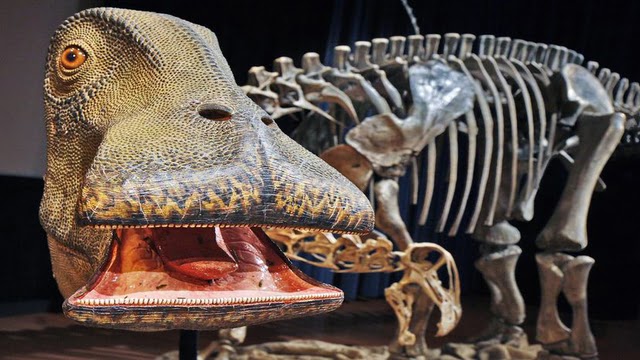Quck answer
Nigersaurus was a herbivorous dinosaur that lived in the Late Cretaceous period. It had a long neck and head, and its most distinctive feature was its numerous teeth – over 500 of them! These teeth were arranged in rows and replaced continuously throughout its life. Nigersaurus likely used its teeth to strip leaves from plants, which it then swallowed whole. Despite its intimidating dental arsenal, Nigersaurus was a peaceful animal that likely roamed in herds. Its unique adaptations allowed it to thrive in the diverse ecosystems of the Mesozoic era.
Extinct Animals

A strange plant-eating dinosaur called Nigersaurus has been reconstructed from bones found in Africa’s Sahara Desert. Scientists have created a model of what the dinosaur’s distinct head may have looked like. The original fossil skull shows that Nigersaurus had a wide snout, wider than the back of its head, which it used to gather food. This unusual dinosaur was given the nickname “Mesozoic Cow” due to its grazing habits and appearance, including over 500 teeth.
Nigersaurus Taqueti: An Unusual Dinosaur
Nigersaurus was around 29 feet long, the size of a modern African elephant, and weighed around 4.4 tons. However, Nigersaurus was a sauropod, a plant-eating dinosaur group that included some of the largest animals to ever walk the Earth. Despite being on the small side compared to other sauropods, Nigersaurus had a distinct feature that caught everyone’s attention: its wide muzzle, which looked like a vacuum cleaner from above.
The Dinosaur with Dental Batteries
Nigersaurus had a unique characteristic that set it apart from other sauropods: dental batteries. These consisted of vertically stacked columns of replaceable teeth, allowing Nigersaurus to house several hundred teeth (old and new) inside its mouth. The upper and lower jaws together had over 500 individual teeth, making it one of the few sauropods with dental batteries. The tooth orientation was also important, as it allowed Nigersaurus to efficiently process its food.
Nigersaurus had a unique dental structure where all the tooth columns were lined up at the front of its mouth. Due to its small size and short neck, it is believed that Nigersaurus fed on low-lying plants at ground level. Its wide muzzle and bountiful teeth made it easy for the dinosaur to shear through vegetation. Nigersaurus had a rapid-fire tooth replacement process, with each tooth being replaced after just 14 days. The posture of Nigersaurus has been debated, with some experts hypothesizing that it walked around with its snout pointed to the ground at a 67-degree angle. The first fossils of Nigersaurus were discovered in the 1950s, but it wasn’t until 1997 that enough material was found to reconstruct about 80% of the dinosaur’s skeleton.
Nigersaurus is a dinosaur that scientists may have found more of if its bones weren’t so fragile. Its skull was described as “featherweight” and some bones were less than 0.08 inches thick. Nigersaurus had hollow bones with air sacs, but its vertebrae contained more air than bone. Although studying these wafer-thin fossils with thin bone plates is challenging, it is necessary. Not all sauropods had long necks like Mamenchisaurus, but many did.
FAQ
What is Nigersaurus?
Nigersaurus is a dinosaur species that lived during the Late Cretaceous period, approximately 119 to 99 million years ago. It was a herbivore that roamed what is now Niger in Africa, hence its name.
What is unique about Nigersaurus?
One of the most unique features of Nigersaurus is its teeth. It had more than 500 teeth arranged in rows along the front edges of its jaws. Its teeth were small, pointed, and continuously replaced throughout its lifetime, helping it to efficiently chew tough vegetation.
What did Nigersaurus look like?
Nigersaurus had a long neck and a small head, which it held close to the ground to feed on low-lying plants. It had a wide, flat snout that was lined with its many teeth. Its body was relatively small, around 9 meters long and weighing approximately 4 tons.
Who discovered Nigersaurus?
Nigersaurus was discovered by a team of paleontologists led by Dr. Paul Sereno in 1997. The team uncovered several partial skeletons of the dinosaur in the Sahara Desert in Niger.
Why is Nigersaurus sometimes called the ‘Mesozoic Cow’?
Nigersaurus is sometimes called the ‘Mesozoic Cow’ because of its herbivorous diet and cow-like appearance. Its small head and long neck allowed it to graze on vegetation close to the ground, similar to cows and other modern grazing animals.
What was Nigersaurus’ ecosystem like?
Nigersaurus lived in a warm, humid environment with abundant vegetation. It shared its ecosystem with other dinosaurs such as the long-necked sauropod Jobaria and the carnivorous Afrovenator.
What happened to Nigersaurus?
Nigersaurus, like all dinosaurs, went extinct at the end of the Cretaceous period approximately 66 million years ago. The exact cause of their extinction is still a topic of debate among scientists.
What can we learn from Nigersaurus?
Nigersaurus provides valuable information about the evolution of herbivorous dinosaurs. Its unusual teeth and feeding habits help scientists understand how these dinosaurs adapted to their environment and diversified over time.
Where can I see Nigersaurus fossils?
Nigersaurus fossils can be seen at several museums around the world, including the Field Museum in Chicago, the National Geographic Museum in Washington, D.C., and the MusГ©e National du Niger in Niamey, Niger.





Leave a Reply